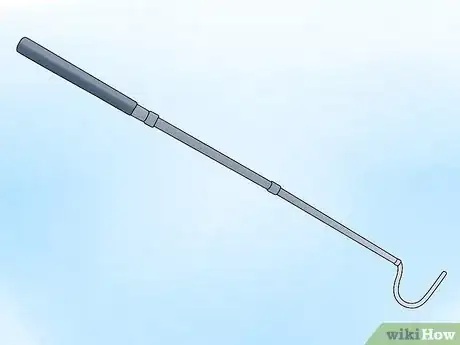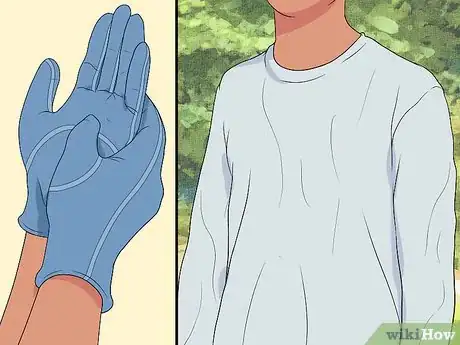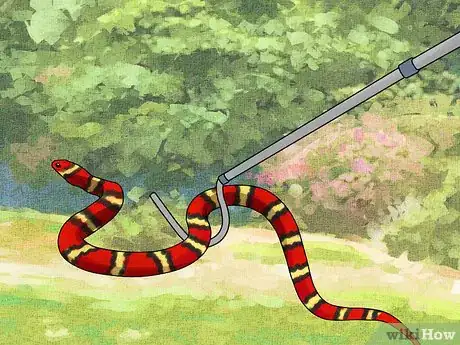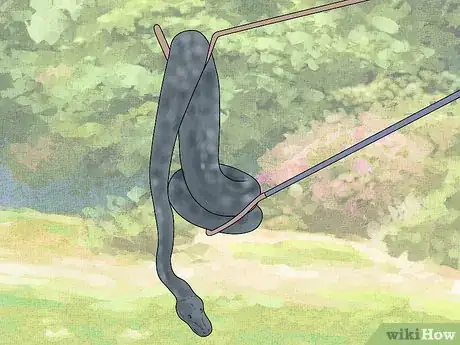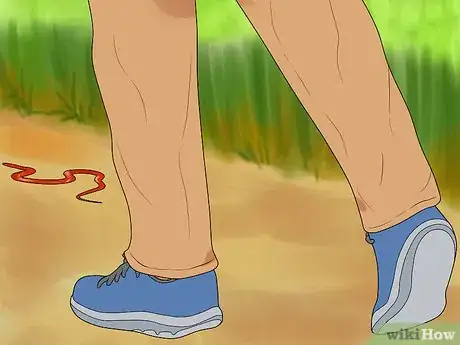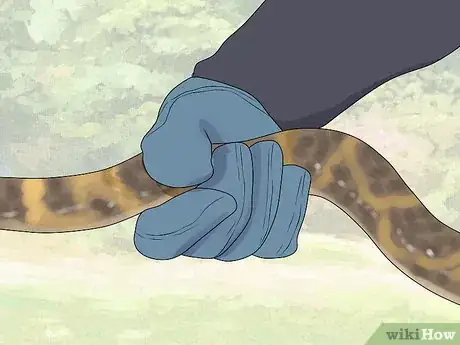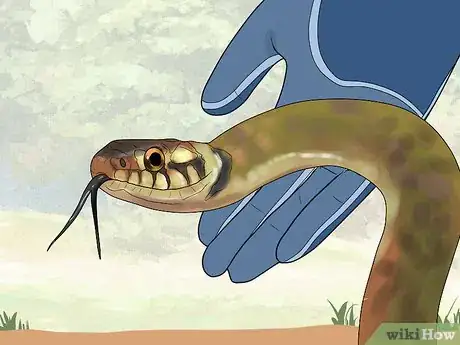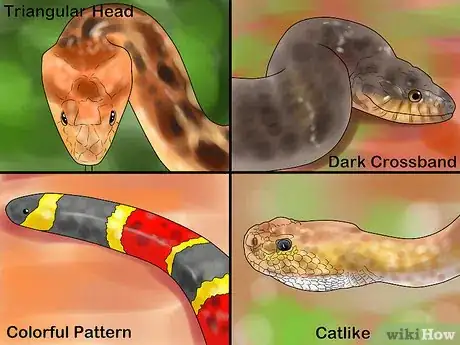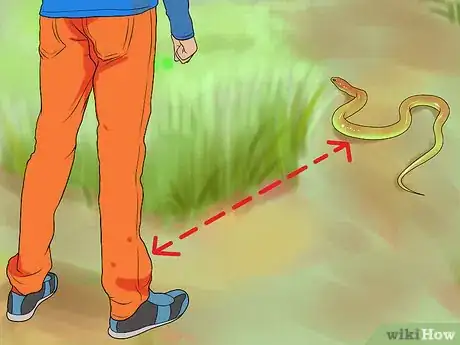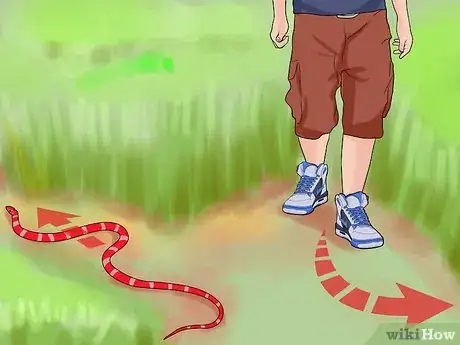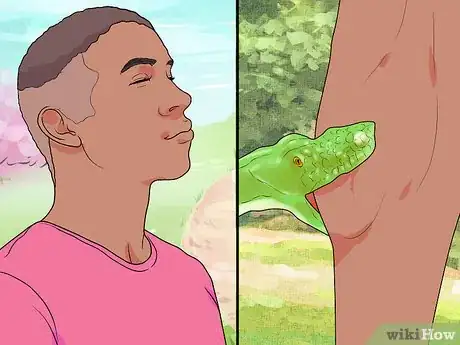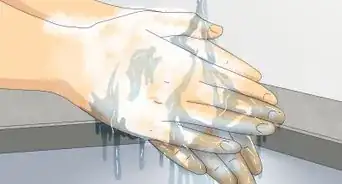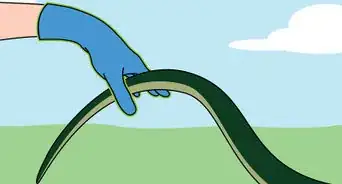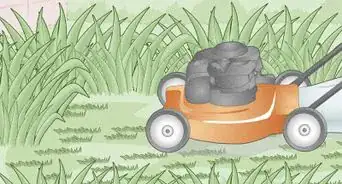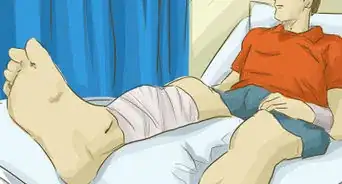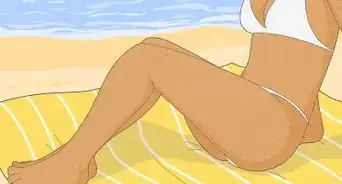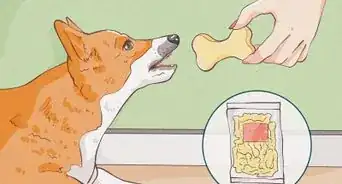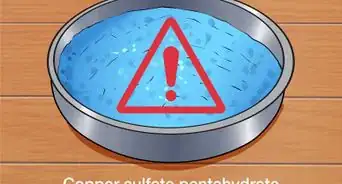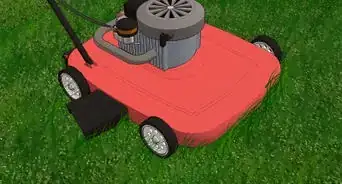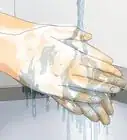This article was co-authored by Chris Parker. Chris Parker is the Founder of Parker Eco Pest Control, a sustainable pest control service in Seattle, Washington. With over seven years of experience, Chris specializes in Integrated Pest Management and doesn’t use any chemicals for pest removal. He offers removal services for ants, rodents, fleas, spiders, wasps, and more. Chris is a certified Commercial Pesticide Applicator in Washington State and received his bachelor’s from the University of Washington.
There are 20 references cited in this article, which can be found at the bottom of the page.
This article has been viewed 31,771 times.
Unless you’re a trained professional, handling a venomous snake is never a good idea. If you’re ever faced with a situation where your or someone else’s safety depends on your ability to deal with a snake-related threat, however, it’s important to know the right way to go about it. The most important thing to remember is to stay alert and keep your distance. Use a snake hook to safely control large and medium-sized snakes from arm’s length, and maintain a firm grip on the snake’s head at all times when holding one by hand. If you encounter a venomous snake in the wild, remain calm and slowly move out of its way to allow it to pass.
Steps
Wrangling Venomous Snakes with a Snake Hook
-
1Purchase a snake hook. If you’re going to be handling a venomous species of snake, the best way to do it is with the aid of a snake hook. These tools are typically made from stainless steel and feature crooked tips and long handles that allow you to lift and manipulate snakes without having to get too close to them.[1]
- You can buy a snake hook online or from select stores that carry snake handling or animal control accessories for around $30-40.[2]
- Another option is to use snake tongs, which have a retractable arm that clamps down over the snake’s body to prevent it from slithering free. The only downside of snake tongs is that the pressure exerted by the arm increases your chances of hurting the animal.
-
2Put on some gloves and protective long-sleeved clothing. Change into garments that completely cover your wrists, forearms, and lower legs. A pair of sturdy closed-toed shoes or boots is also a must. You want to make sure there’s no exposed skin showing in vulnerable areas that will be in close proximity to the snake.[3]
- Durable materials like denim, leather, and canvas will do the best job of defending against an unexpected bite.[4]
Advertisement -
3Use the curved section of the hook to lift the snake under its upper body. Slide the curve of the hook under the snake’s belly, then scoop it up and hold it 1–2 feet (0.30–0.61 m) above the ground with the end of the tool a safe distance away from your body. Adjust the position and angle of the hook as needed to respond to the snake’s movements and keep it perched securely.[5]
- Snake hooks are most effective for controlling large, slow snakes that are less likely to slip off of the hook.[6]
- Snake hooks are simple tools, but it can take a little while to get the hang of using one. Try practicing on rubber toy snakes or lengths of rope to prepare to deal with snakes of various sizes.
Tip: For maximum balance and leverage, am to place the hook at the snake’s midpoint or slightly closer to its head.
-
4Grab a second hook if you need to control an especially big snake. If you’re attempting to maneuver a particularly large specimen, such as an adult cottonmouth, it may be necessary to wield a pair of hooks. Use the hook in your dominant hand to lift the snake’s upper body like normal and support its lower body or tail section with the other hook.[7]
- Remember to keep the hook controlling the head extended away from you at all times so the snake can’t get close enough to strike at you.
Holding Snakes by Hand
-
1Wear gloves anytime you’ll be handling venomous snakes. Thick, rugged gloves like the kind used for gardening or construction will offer the most protection. If nothing else is available, you can also use a pair of cycling or winter gloves. It’s also a good idea to pull on some long-sleeved clothing to cover your extremities.[8]
- Snake handling gloves are your best option. Since these are designed specifically for interacting with venomous snakes, they provide superior flexibility and traction while being impenetrable to even the sharpest fangs.[9]
Warning: It’s simply not safe to try to pick up or hold venomous snakes with your bare hands, even if you’re an experienced professional.
-
2Approach the snake slowly from behind. Circle around the snake cautiously until its head is facing away from you. Step towards it softly, being careful not to stomp your feet or make too much noise.
- Never attempt to pick up a venomous snake head on or from the side. Many snakes have very acute vision, and can strike rapidly and without warning.[10]
- Snakes attack when they feel threatened, and excessive noise or wild, chaotic motions may agitate them.
-
3Grip the snake behind its jawbone with your thumb and forefinger. Lean down and quickly take hold of the snake with your dominant hand. Pinch the snake’s upper neck region between your first finger and thumb, the way you would hold a remote control. Once you've got your hand around it safely, don't let go![11]
- Don’t try to grab the snake with a fist or any other hand position. By doing so, you’ll be sacrificing the sensitivity needed to feel and respond to the snake’s movements.
- Make sure you keep the knuckles of both fingers, as well as all other digits, away from the snake’s jaws at all times.
-
4Squeeze the snake firmly to maintain control of its head. Hold the snake at arm’s length and continue applying steady pressure the whole time you have it in your hand. Otherwise, you may lose your grip, a mistake which could have dangerous consequences.[12]
- Try not to squeeze the snake too hard, or you could accidentally strangle it or break its neck.
- Never pick up a venomous snake with the intent of killing or maiming it. Not only does this harm the animal unnecessarily, it also puts you at serious risk of being bitten.
-
5Control the snake’s body with your free hand. Place your opposite hand right around the snake’s midpoint, or clamp down closer to the tail to prevent it from wriggling free. Using both hands will allow you to better manage the snake’s full length and reduce the likelihood of an unintended escape.[13]
- Tucking the tail section beneath your armpit or pressing it between your thighs can make it easier to restrain larger species like king cobras and black mambas.
-
6Release the snake tail-first and back away quickly. When you’re ready to put the snake down, stoop low so that you’re holding it just above ground level and loosen your grip on it's body. Then, in one fluid movement, let go of the head, stand up, and retreat from the snake until you’re out of striking range.
- Don't try to hand off a venomous snake to another person. If you need to transfer possession, it’s safest to just set it down and pick it up again.
-
7Wash your hands thoroughly after handling snakes. Immediately after releasing the snake, scrub your hands, wrists, and lower forearms with warm water and antibacterial soap for at least one full minute to make sure they’re clean. It’s not uncommon for snakes to carry diseases, bacteria, and other harmful substances that could make you ill if you don’t take steps to properly sanitize your extremities.[14]
- It’s important to give your hands a good washing even if you wore gloves to hold the snake, as it’s possible for contagions to spread from another part of your skin.
- You’ll also need to wash your hands before you pick up venomous pet or show snakes, especially if you’ve recently handled live prey.[15]
Dealing with Venomous Snakes in the Wild
-
1Look for tell-tale signs that the snake is venomous. Anytime you cross paths with a snake, your first task should be to determine whether or not it’s the lethal variety. Triangular heads, dark crossbands, colorful patterns, and catlike, elliptical eyes are examples of features common to venomous snakes, but there are many more, and some of these features may also apply to non-venomous species.[16]
- Whether or not a certain snake is venomous, you should leave plenty of space between you and it to avoid provoking an attack.
- Keep in mind that there are hundreds of different species of snakes. For most people, this diversity will make it impossible to identify one that's venomous at a glance.[17]
-
2Keep your distance from the snake if at all possible. As soon as you spot a snake that you think might be venomous, stop moving and avoid coming any closer. Snakes will often head for cover in the surrounding undergrowth when surprised, so give the animal plenty of room to escape and defuse the threat on its own.[18]
- If you have small children or pets with you, get them clear of the scene first. They’re more likely to behave in a way that will frighten the snake into lashing out.[19]
- Try not to position yourself between the snake and any nearby brush, rocks, fallen logs, or root holes where it may try to flee.
-
3Walk away from the snake slowly and allow it to pass. Be careful not to make any sudden movements. If you’re standing close, the snake might interpret this as an act of aggression. Once you’re far enough away to not seem like an immediate threat, most snakes will simply move along, allowing you to do the same.[20]
- If you happen to step directly on a snake or wander a little too close, don't panic. Just take a few steps back in a calm, unhurried manner and put as much distance as you can between you and the snake.
- Don’t attempt to follow the snake or do anything to interfere with its exit. If you do, you could be putting yourself right back in harm’s way.
Warning: Never pick up, strike, or shoo away any snake you encounter in nature unless it’s absolutely necessary to ensure the safety of you or a loved one.[21]
-
4Stay calm and seek help right away if you or a companion is bitten. Before you do anything else, call the emergency medical service for your area and confirm that they’re on their way. Instruct the bitten party to sit down and remain as still as possible. Remove any constrictive clothing, jewelry, or other accessories that may inhibit swelling, and if you can, wash the wound with disinfecting soap to minimize the risk of infection.[22]
- If you’re somewhere with no internet or cell service, yell loudly for help to anyone who might be in earshot.
- Under no circumstances should you cut, puncture, or apply ice, pressure, or electricity to the bite area. The idea that you can save a snake bite victim’s life by sucking out the venom is also a myth. Contrary to popular belief, these actions will just make the injury worse.[23]
Expert Q&A
-
QuestionHow can to prevent snakes from entering your home?
 Chris ParkerChris Parker is the Founder of Parker Eco Pest Control, a sustainable pest control service in Seattle, Washington. With over seven years of experience, Chris specializes in Integrated Pest Management and doesn’t use any chemicals for pest removal. He offers removal services for ants, rodents, fleas, spiders, wasps, and more. Chris is a certified Commercial Pesticide Applicator in Washington State and received his bachelor’s from the University of Washington.
Chris ParkerChris Parker is the Founder of Parker Eco Pest Control, a sustainable pest control service in Seattle, Washington. With over seven years of experience, Chris specializes in Integrated Pest Management and doesn’t use any chemicals for pest removal. He offers removal services for ants, rodents, fleas, spiders, wasps, and more. Chris is a certified Commercial Pesticide Applicator in Washington State and received his bachelor’s from the University of Washington.
Pest Control Specialist Snakes typically find their way into the home by tunneling, just like rats. They're probably on your property looking for a food or water source. To prevent them, remove water and food sources and any places that they can hide under. For example, children's toys in the yard that have not been moved in a long time. Those are great tiny hiding spots as well as things that collect water. Removing those off the property is very helpful.
Snakes typically find their way into the home by tunneling, just like rats. They're probably on your property looking for a food or water source. To prevent them, remove water and food sources and any places that they can hide under. For example, children's toys in the yard that have not been moved in a long time. Those are great tiny hiding spots as well as things that collect water. Removing those off the property is very helpful. -
QuestionHow would I deal with the venom that just got injected in my body?
 Community AnswerTake the animal alive to your doctor, and tell them where the bite is. If it is a highly toxic snake, they will make an antivenom.
Community AnswerTake the animal alive to your doctor, and tell them where the bite is. If it is a highly toxic snake, they will make an antivenom. -
QuestionWhat should I do if a snake is under a brick on my porch?
 Community AnswerThe best thing to do would be to leave the snake alone. It will move on soon enough. If you cannot wait for the snake to leave on its own, then you can use a broom (or something else with along handle) to gently push at the snake and encourage it to slither away.
Community AnswerThe best thing to do would be to leave the snake alone. It will move on soon enough. If you cannot wait for the snake to leave on its own, then you can use a broom (or something else with along handle) to gently push at the snake and encourage it to slither away.
Warnings
- Never handle venomous snakes for show or for the sake of impressing others unless you’re qualified to do so as part of your profession (if, for instance, you’re a snake handler, zookeeper, or wildlife management expert).⧼thumbs_response⧽
Things You’ll Need
Wrangling Venomous Snakes with a Snake Hook
- Snake hook
- Protective gloves
- Thick, durable long-sleeved clothing
Dealing with Venomous Snakes in the Wild
- Disinfectant soap
- Bandages (optional)
- Snake bite kit (optional)
Holding Snakes by Hand
- Rugged gloves
- Protective long-sleeved clothing
- Antibacterial soap
- Warm water
References
- ↑ http://www.aaanimalcontrol.com/blog/snakehook.html
- ↑ https://www.sniffoutdoors.com/best-snake-hook/
- ↑ https://www.universalcitytexas.com/704/How-To-Deal-With-Snakes-Around-Your-Home
- ↑ https://www.outsideonline.com/1775816/what-material-will-protect-me-snakebites
- ↑ http://www.aaanimalcontrol.com/blog/snakehook.html
- ↑ http://www.snakeremovaltrap.com/removal.html
- ↑ https://www.youtube.com/watch?v=tCf-4c-JpjA&feature=youtu.be&t=195
- ↑ http://www.snake-removal.com/barehands.html
- ↑ https://www.hixmagazine.com/best-snake-bite-proof-gloves/
- ↑ http://www.anapsid.org/sight.html
- ↑ https://www.nytimes.com/2017/06/30/magazine/how-to-hold-a-venomous-snake.html
- ↑ https://www.youtube.com/watch?v=NJDJ1FPJx7Q&feature=youtu.be&t=170
- ↑ https://www.nytimes.com/2017/06/30/magazine/how-to-hold-a-venomous-snake.html
- ↑ http://www.reptilesmagazine.com/Reptile-Care-For-Beginners/13-Tips-to-Better-Reptile-Handling/
- ↑ https://cobras.org/handling-snakes-golden-rules/
- ↑ https://tpwd.texas.gov/education/resources/texas-junior-naturalists/be-nature-safe/venomous-snake-safety
- ↑ http://www.snake-removal.com/venomous.html
- ↑ http://www.nature-reserve.co.za/snake-encounter-tips.html
- ↑ http://ufwildlife.ifas.ufl.edu/safely_dealing_with_snakes.shtml
- ↑ https://www.uaex.edu/publications/pdf/FSA-9102.pdf
- ↑ https://nt.gov.au/environment/animals/keeping-wildlife-as-pets/keeping-snakes/handling-venomous-snakes
- ↑ https://tpwd.texas.gov/education/resources/texas-junior-naturalists/be-nature-safe/venomous-snake-safety
- ↑ https://safety.fsu.edu/safety_manual/supporting_docs/SLU%20Snake%20Safety.pdf
- ↑ https://cobras.org/handling-snakes-golden-rules/
About This Article
Before you try to handle a poisonous snake, keep in mind that it's never safe to handle a poisonous snake unless you're trained professional. If you encounter one in the wild, keep your distance and leave the area slowly. If you have to move a poisonous snake, use a snake hook to safely handle it at a distance. To handle a poisonous snake using your hands, make sure you're wearing thick, rugged gloves in case it bites you. To learn how to treat a snake bite from a poisonous snake, scroll down!
